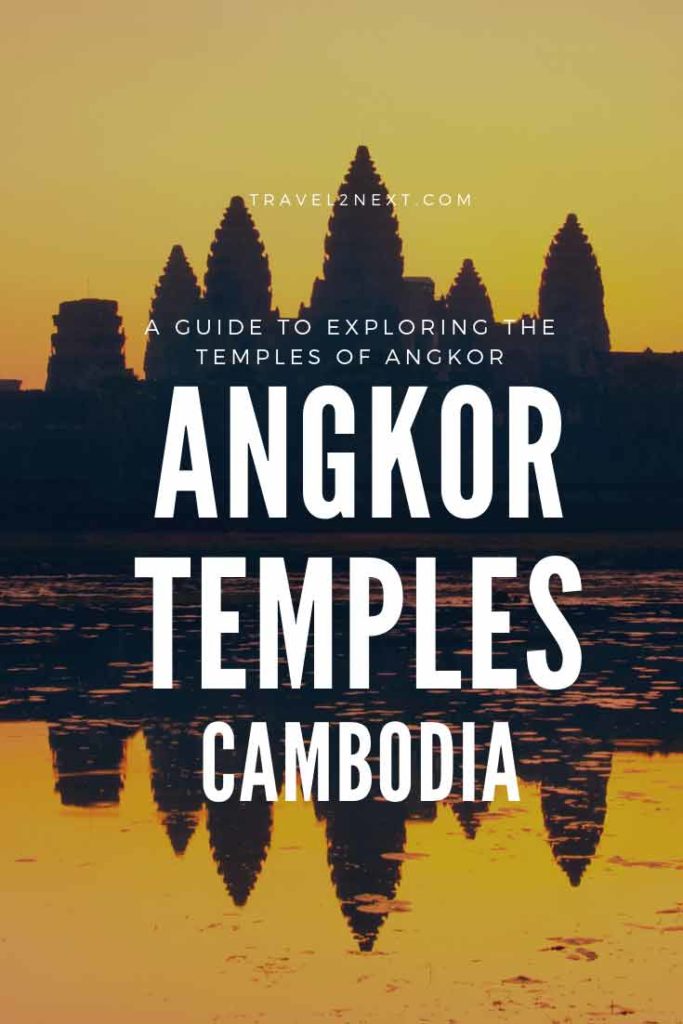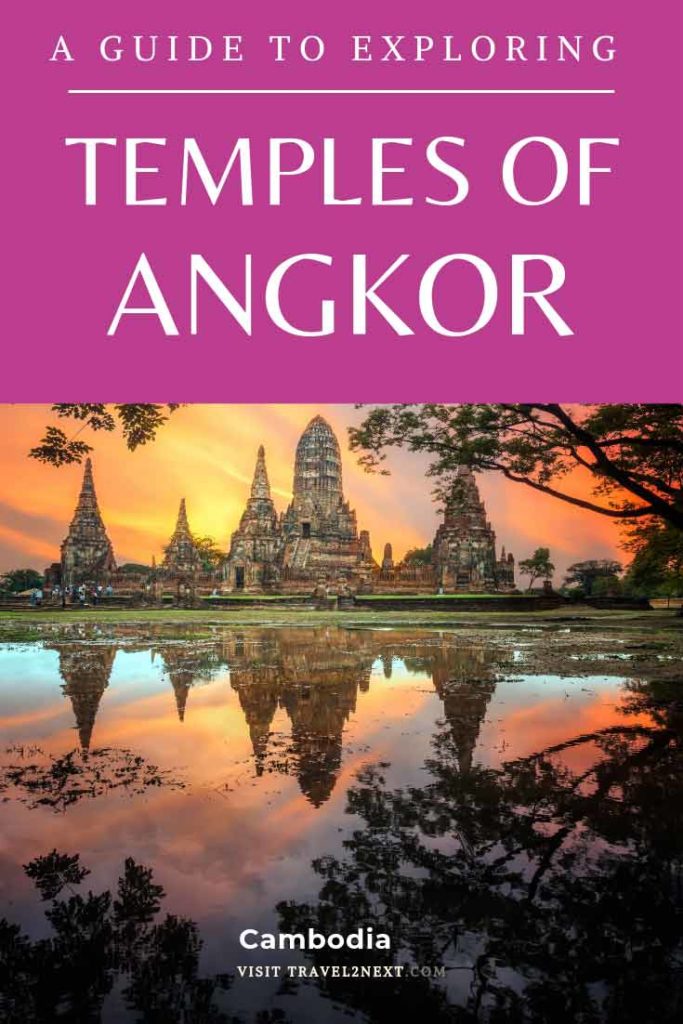Visiting the temples of Angkor should be on anyone’s bucket list. One of the world’s greatest historical sites and the subject of films and fiction, there’s a magical element to Angkor that captures the imagination and plunges you headfirst into an ancient world.
Visiting Angkor Wat and the other temples of Angkor in Siem Reap is one of the top things to do in Cambodia. Visiting temples should be part of any Cambodia itinerary but if you have limited time, spending it at the right temples can make all the difference.
So, here’s a guide to help you plan your experience of this epic destination to its fullest.
Contents
Temples of Angkor
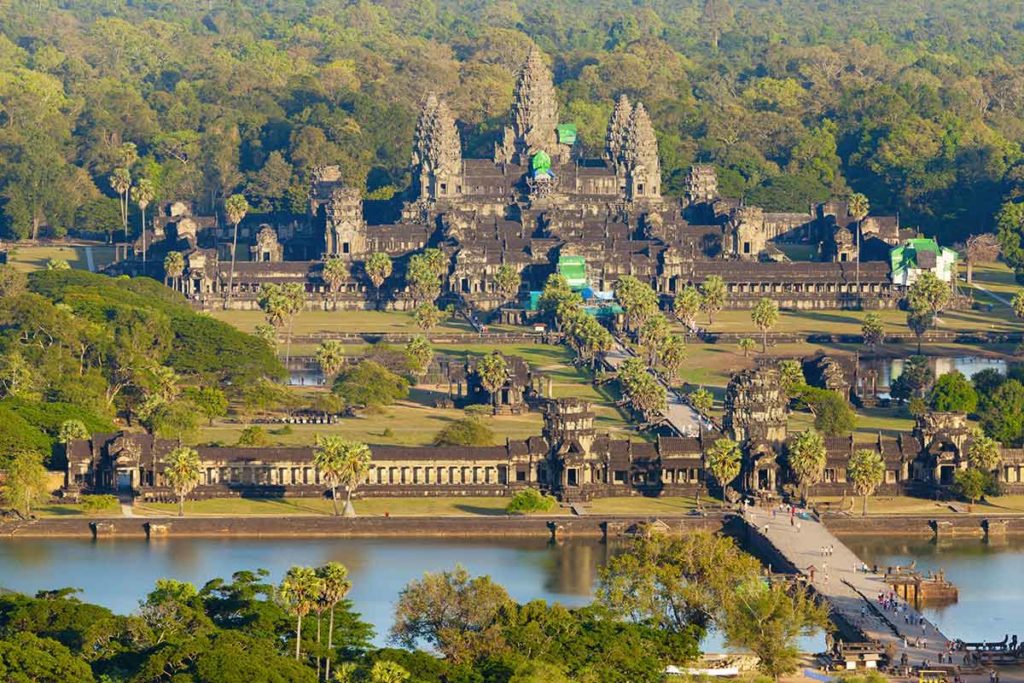
History and Significance of the Temples of Angkor
The awe-inspiring ancient city of Angkor in the Siem Reap Province, near modern-day Siem Reap north of the Tonle Sap Great Lake.
There are some unique things to do in Siem Reap but exploring its temples is something you really shouldn’t miss.
Between the 9th and 15th centuries Angkor was the largest city in the world and capital of the Khmer Empire.
It was home to approximately 1,000,000 people in its heyday and stretches over 400 square kilometres, encompassing over 1000 temples.
The majesty of this UNESCO World Heritage Site is a direct result of an epic game of kingly one-upmanship.
Effectively, successive Khmer rulers fought to outdo their predecessors, designing and constructing continually greater temples of Angkor and venues in their bid to dominate the landscape and stamp their claim on history.
This process culminated in the World’s largest religious monument, the famed and glorious Angkor Watt, which is now proudly positioned on Cambodia’s national flag.
Understandably so, Angkor is one of Cambodia’s most popular tourist destinations, drawing two million visitors to its temples every year.
Situated in the midst of rich Cambodian forest and farmland, this huge conglomerate of architectural and historical wonder feels like a lost and secret world.
Angkor is a place of awe and sublimity that should be on everyone’s bucket list.
How To Visit The Temples of Angkor
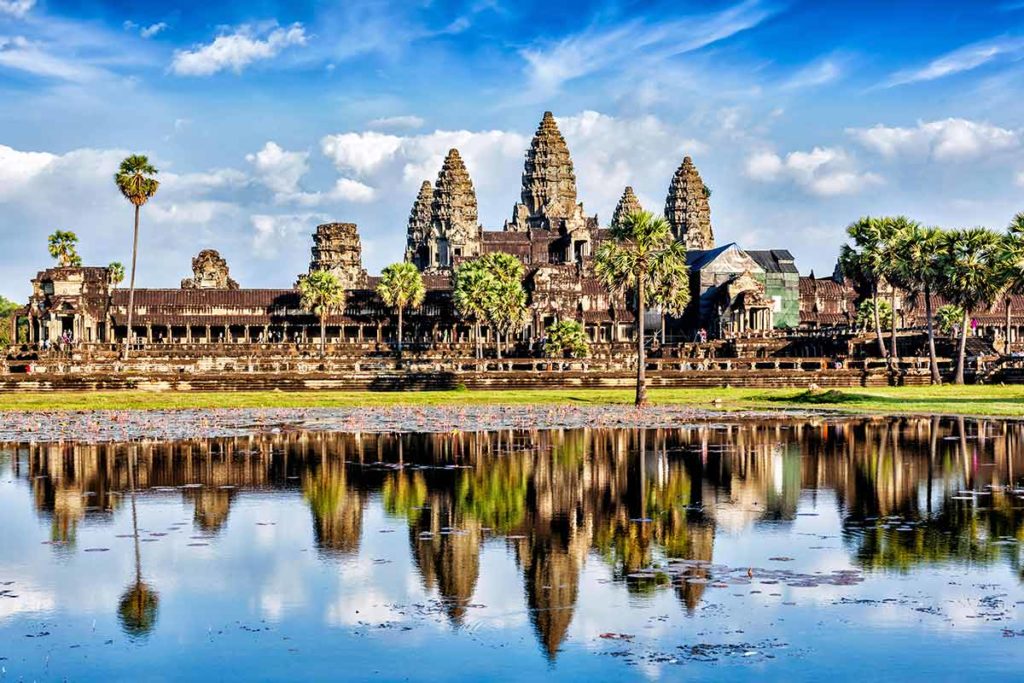
Angkor Wat Tickets
The Angkor Pass must be purchased from the official ticket office located 4km outside of Siem Reap town.
Address: Street 60, Krong Siem Reap, Cambodia. The office is open between 05.00 – 17.30 every day.
To get there, all tuk-tuk drivers know the way and can take you before heading to the temples, or hire a bike and grab a map from your hostel info desk.
After a price increase in early 2017, tickets are annoyingly expensive these days, though Cambodians and under 12s do go free.
There’s no student discount either, but the price includes a $2 donation to a local Children’s Hospital, which is cool.
| Ticket price | |
|---|---|
| 1 Day | $37 |
| 3 Days | $62 |
| 7 Days | $72 |
If you’re looking at those prices and thinking ‘there’s no way I’m paying that’, then I can empathise!
But you can’t not see the temples.
I’m all for budgeting, but seriously, pay the money!
The temples of Angkor are worth it.
I would recommend getting the three-day pass to make sure you have time to see as much as you can.
I’d caution against any temptation to see the temples without a ticket too.
Access to the temples requires getting through a waypoint where tickets are checked and hole punched- there are heavy fines for being caught in the temple complex without a ticket.
Good news though, you don’t need to cover the temples all in one go, which can be a daunting prospect.
From the issue date, the 3-day pass is valid for 10 days and the 7-day pass is valid for 1 month. So, there’s no need to visit on consecutive days.
Money saving tip: Buy your ticket after 5 pm and you’re able to enter the Angkor temple complex without using your allotted days.
This means you can technically enter the park and explore before it closes, and still have all your days remaining.
Why not use the time to watch the sunset at Angkor Wat?
Temples of Angkor Dress Code
Just a quick note to emphasise that many of the temples of Angkor are still active places of worship, so shoulders and knees should always be covered.
It’s also important to abide by the dress code when purchasing your tickets too, as they may not let you buy them otherwise.
Best Time for Visiting Angkor Wat and Surrounding Temples
Here are the essentials on what month to visit Angkor Wat:
- the cool, dry months of November to March are comfortable but busy
- June to October is quieter but hot and wet
- April is Khmer New year, so it’s especially busy.
Best time of day to visit Angkor Wat is:
- Lunchtime
- Early or later in the day (around 5 am or 4 pm)
Getting around the Temples of Angkor
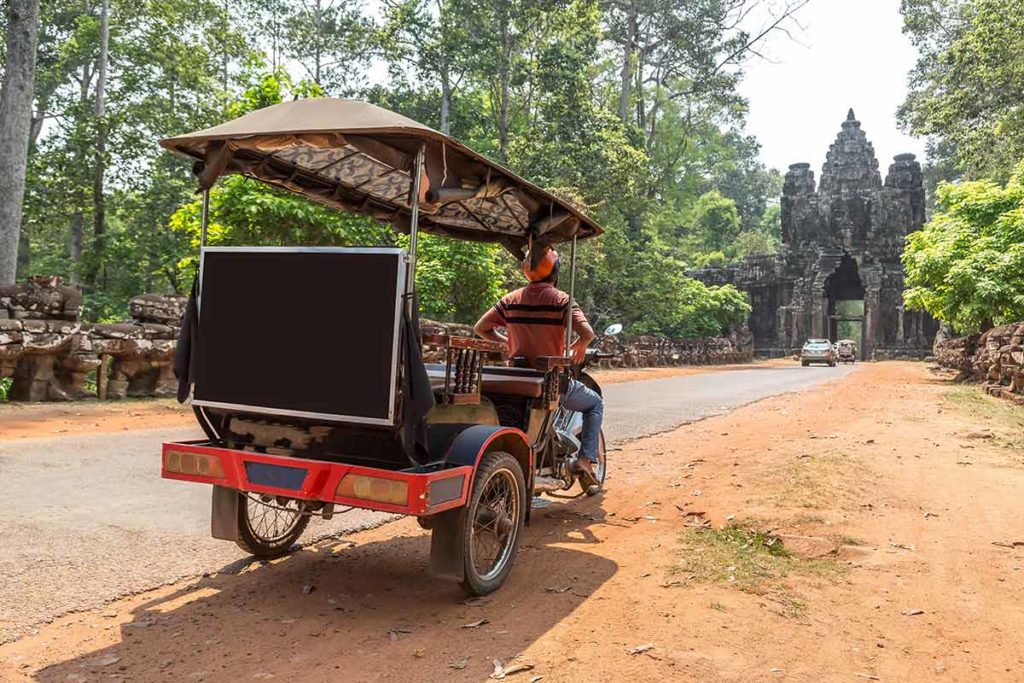
The most important part of exploring Angkor is to take your time.
If you only have 24 hours, then, of course, that’s fine – embrace them but, if you can at all spare a few days then you should really consider doing it.
There’s a huge amount to see and a felt pressure not to miss anything out.
Under time pressure, it’s easy to rush around the highlights without stopping to take it all in.
Speaking from experience, even spread over multiple days without rushing and with an ultralight backpack, seeing the temples is a tiring endeavour.
You want to make the most of it.
If you can, spend a whole afternoon in one location, ambling around this unparalleled place.
Wondering how you’re going to get to the site and explore the temples? Here are some options:
1- Hire a tuk-tuk
By far the easiest option is to hire a tuk-tuk for the day.
It’s not the cheapest (count on about US$20 for the day and don’t be surprised if you have to pay out more) but it is definitely convenient.
Your driver can transport you to the ticket office first and then shuttle you around wherever you wish to go.
If the weather is scorching hot or pouring with rain, you might be thankful for the shelter, as well as the local knowledge of your driver.
Aside from the expense, you’re also somewhat obligated to your driver, which may inhibit the amount of time you wish to spend in places.
It’s flexible, but it’s not as flexible as being in total control of your time.
2- As part of an Angkor temple tour
This wouldn’t be my first choice, but there are a huge number of services running tours of Angkor and it’s a relatively easy way to see the best bits, all in the comfort of an air-conditioned bus.
However, you’ll be sharing with a dozen (probably more) people and your time is not your own.
You’ll have to move when the bus moves from temple to temple, according to their schedule.
Here are some Angkor Wat tours to book if you’re like someone else to take care of the planning.
3- Rent a bike
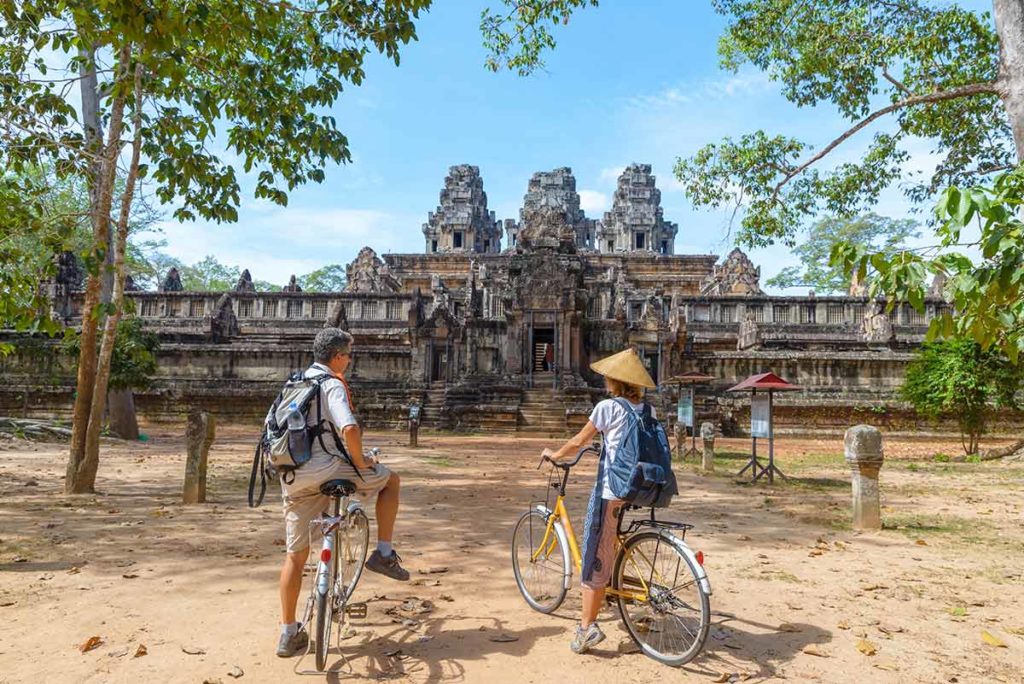
The main sites of Angkor are approximately an 8km cycle over flat land from Siem Reap.
Cycling to and around Angkor Wat won’t be for everyone and you’re at the mercy of the elements but this is a fantastic travel hobby that I always encourage people to do on the road.
Travelling by bicycle is always awesome and it’s a spectacular way of exploring the temples. It’s also spectacularly cheap ($1-2 to hire a bike for the entire day).
By bike you have total control of your movements and time: go where you wish for as long as you like.
Obviously, it’s eco-friendly, which is great, but by moving slowly you also get to take in your environment better too.
Gliding through the rice paddies and into the temples grounds that surround you is a serene experience.
The bikes you rent in Cambodia are generally of (hilariously) questionable quality, but most are fit for purpose.
Just make sure you get your tyres pumped up and to take it for a test ride around first, just to make sure it will get you all the way to the temples and back in one piece!
Temples of Angkor – The Two Circuits
This post would be about 200 pages long if I tried to list all the temples of Angkor so, for my sake and yours, I’m not even going to try.
Equally, there are some great resources already online that detail the temples in full here and here.
The tourist trail around Angkor comprises two main circuits: a ‘small’ one and a ‘grand’ one.
Essentially, at some point, people got together and decided the best bits for tourists to see in relation to the amount of time they have.
Obviously, if you’re short on time, the small circuit could be a good bet but with a bit more time to play with, the grand circuit might be better.
The consensus seems to be that the grand circuit should be done only if you have two or three days to spend as there’s simply too much to see.
It’s also worth noting that Angkor is not restricted to these routes: there is far more to see beyond the reach of them.
Think of the circuits as footnotes to the complex: the highlights assembled into an easily navigable route.
Now, there’s no actual reason to stick to them either, so feel free to follow a less trodden path if you wish. However, they’re pretty good at demarcating most of the highlights of the Angkor temple complex, so I wouldn’t forgo the circuits entirely, just for the sake of doing things differently.
Here’s a brief summary:
Small Circuit
Beginning at Angkor Wat this circuit is 17km in length and takes you through the major temples of Angkor Thom, Ta Prohm, and Banteay Kdei.
It also passes more minor (but still exceptional) temples such as the Baphoun, The Terrace of the Leper King, The Terrace of the Elephants, the Twelve Prasats, Spean Thma and Sras Srang.
You finish where you started at to Angkor Wat.
Grand Circuit
This extended circuit is 26km long and, as well as those of the small circuit, takes you past Preah Khan, Preah Neak Pean and to the Eastern Mebon, as well as the monuments such as Ta Som and Preah Rup.
This circuit also finishes back at Angkor Wat.
Best Places to Photograph An Angkor Sunrise
If your intention is to photograph an Angkor Wat sunrise, make sure you get there early to get a good spot (the gates open at 5 am) beside the reflection pools.
It’s a good idea to pack your breakfast to fuel up while you’re waiting for the sunrise and make sure you bring a torch.
- Srah Srang
- Phnom Krom
- Angkor Thom
- Bayom Temple
Best Places To Photograph An Angkor Sunset
If getting in line before dawn is too early for you, the best place to photograph an Angkor Wat sunset is from the east side of the complex. Other places to go for amazing Angkor sunset shots are:
- Phnom Bakheng
- Angkor Thom (at the south gate)
- Bayon Temple
Siem Reap Temples
Now, on to the temples themselves.
Like I mentioned above, it felt like too big of a task to go through them all, so I’ve chosen a selection instead, which represent my picks of the must-see Siem Reap temples.
There are also some temples in northern Thailand worth visiting, such as Prasat Hin Phimai and Phnom Rung Historical Park.
Angkor Wat
Angkor Wat is probably the most well known of the thousands of temples in Angkor for good reason.
Honestly, the word building falls short of doing Angkor Wat justice.
Angkor Wat is simply sublime.
Rising majestically from the forest, the largest religious building in the world is set in stunning grounds, across a moat that takes you to the heart of the temple.
It’s alien, ineffable and hugely inspiring.
You could almost spend a day here, exploring the rooms, courtyards and maze-like sets of stairs and corridors.
Of course, Angkor Wat’s great beauty and renown attracts lots of people.
Tourists and travellers flock from sunrise to witness the full glory of the rising sun as it climbs high above the ornate conical turrets of the temple.
The crowded nature of the place remains consistent throughout the day too, so there’s no escaping the crowd. You just have to accept it.
After all, you’re all there for the same reason: to celebrate and explore the magnificence of this historical treasure.
Angkor Thom and Bayon
To enter Angkor Thom, you cross a stone bridge over glistening blue waters of the moat, with carved talismanic figures to right and left.
Entering through the giant square compound of Angkor Thom in this manner sets the tone: it’s hard not to be impressed.
I felt like I was in Indiana Jones and it was awesome.
Inside, Angkor Thom houses multiple points of ‘Angkor-ian’ interest, including the main one at its heart: the 12th-century Bayon.
This mesmerising state temple of Jayavarman VII has 54 Gothic towers, decorated with 216 huge smiling faces of Avalokiteshvara and is decorated with 1200m of remarkable bas-reliefs, incorporating over 11,000 figures.
Walking the stone causeways and dipping in and out of ornate rooms, restored to all their historic glory, you’re constantly greeted with Bayon’s stone faces, staring down at you.
This is a hugely popular site though and every nook seems covered in excitable tourists happily snapping away with their cameras.
Avoid peak times if possible.
Baphuon
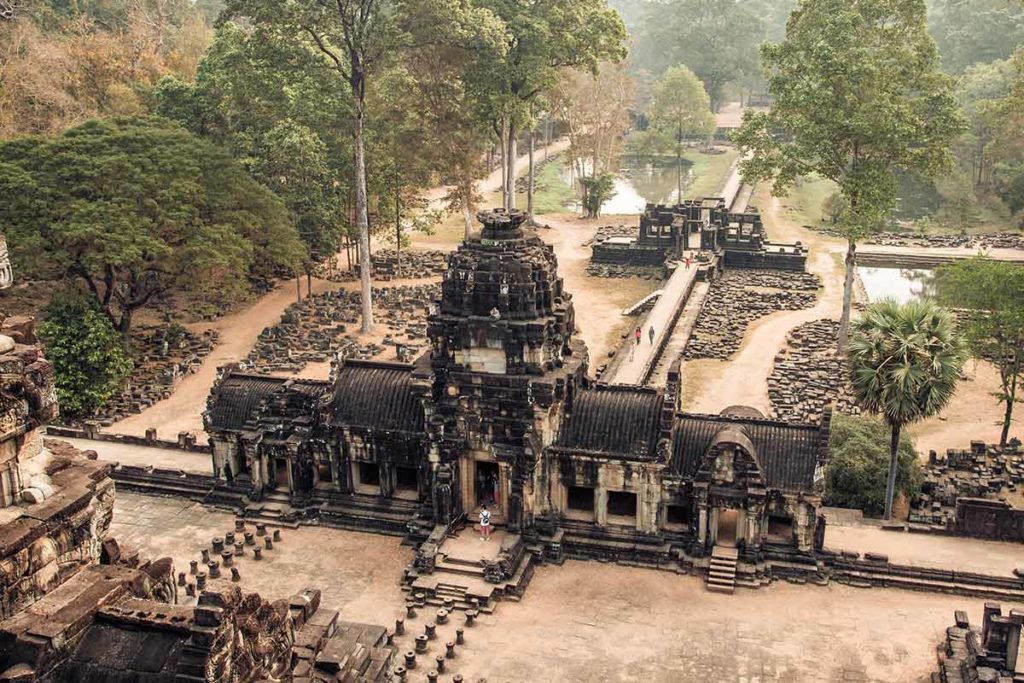
The Baphuon is another temple situated within the walls of Angkor Thom.
This three-tiered sandstone temple dates back to the 11th century and doesn’t fail to impress.
Access Baphuon along the stone walkway on its Eastern side.
Slightly above ground level, you can practically imagine yourself as a Khmer King, striding towards the mountain-like temple that rises proudly before you.
It’s an impressive sight.
Look closely on the Western side and you can make out the rough shape of a 70m reclining Buddha, which was built (but never finished) in the 15th century when Baphuon was converted to a Buddhist monastery.
Ta Prohm
For lovers of Indiana Jones and Tomb Raider, Ta Prohm is going to be heaven (both were filmed here!).
This magical ruin of an ancient temple is the meeting point of jungle and masonry.
The temple is gradually being reclaimed by the jungle.
It feels like you’ve stepped firmly into another lost world in Ta Prohm.
Thick roots of gargantuan Kapok trees grow mercilessly over 12th century stone- great boulders forcibly prised from their place by natural giants, gripped and intertwined with nature, in a battle of ages.
It’s otherworldly, ethereal, somewhat surreal, picture-perfect and another tourist hot spot.
Get there early or late (avoid peak time between 10 am and 2 pm) to steer clear of the masses of people that flock through every day.
Preah Khan
Preah Khan is another immensely impressive temple and one of the largest complexes of Angkor.
It was built in the 12th century and the walled enclosure measures roughly 700x800m, with the temple at its centre.
To access Preah Khan you cross another stone walkway, between the wonderfully carved monoliths (reminiscent of the entryways of Angkor Thom) of divine beings and demons that line the sides.
Inside, marvel at the delicate stone reliefs of the interior walls and explore the endless galleries and courtyards, complete with mighty Kapok trees (like Ta Prohm).
Preah Khan is slightly less touristy than the temples I’ve mentioned so far, which may appeal to some.
Phnom Bakheng
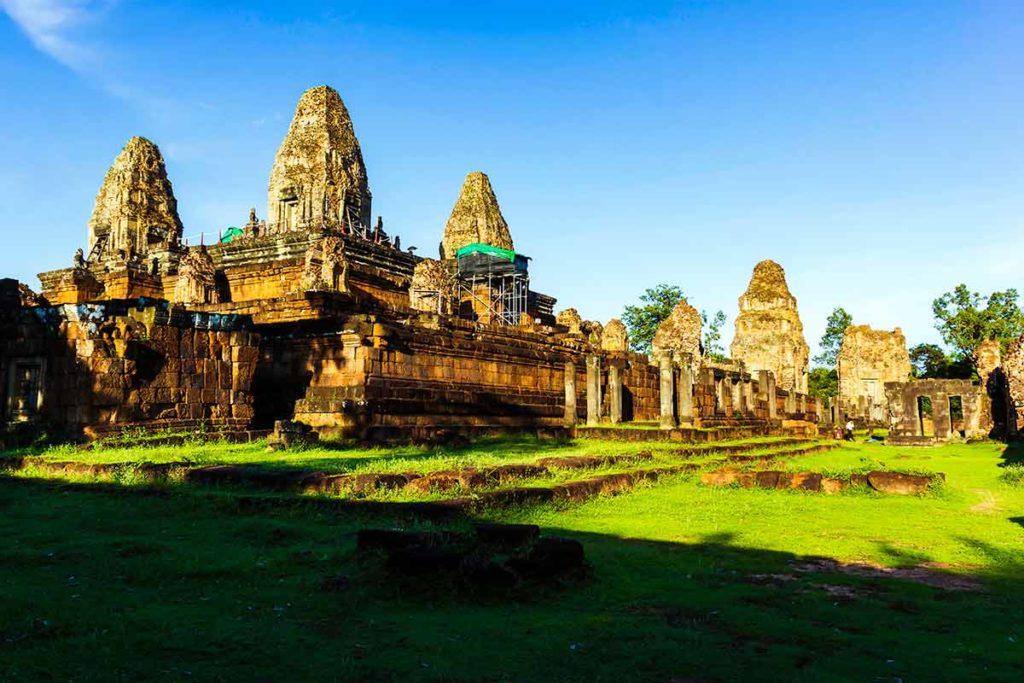
Phnom Bakheng is a good temple to visit for an Angkor sunset photo.If you’re looking for a place to watch the sunset over Angkor, then you can’t go wrong with Bakheng.
This five-tiered temple mountain is renowned for the view over Angkor and you can snap a good pic of Angkor Wat (1.3km away) with the right lens.
However, get there early (approx 4 pm) to avoid disappointment.
Due to crazy numbers of tourists competing for space in the past, numbers are now restricted to 300 at the temple (for sunset) at any one time.
Banteay Srei
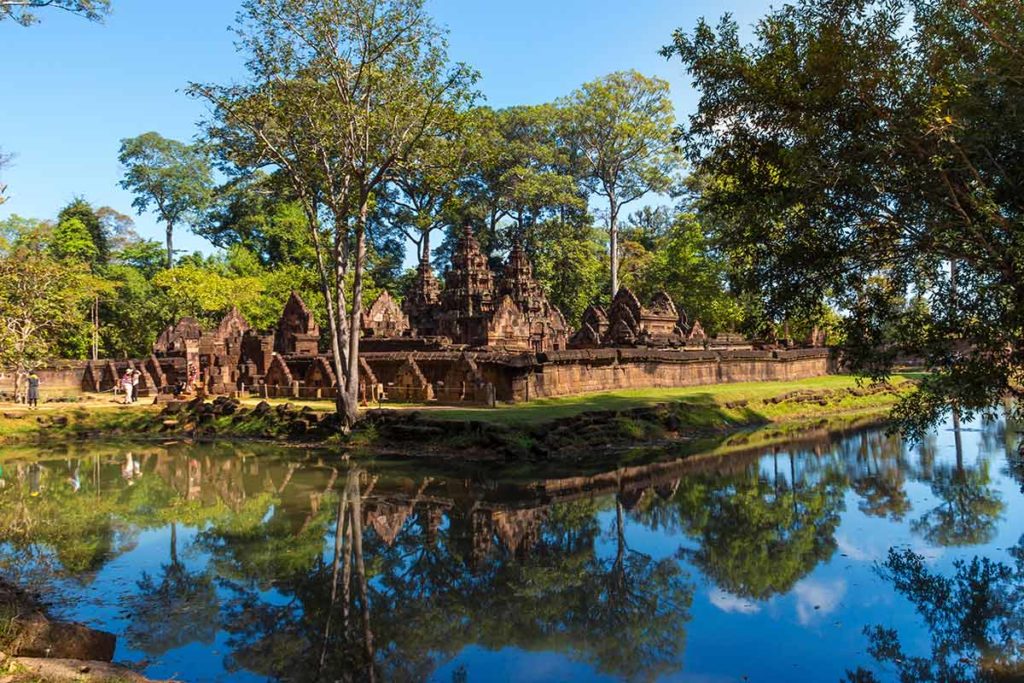
This temple is 32km north of Siem Reap, so it’s far further afield than most of the others.
It’s worth the trip – not just for the scenic route that gets you there but also for the temple at the end.
This 10th-century temple translates to “Citadel of the Women” and the story goes that women must have built it, for the carvings that adorn its walls are supposedly too fine to have been done by the hands of men!
The intricacy and detail of the reliefs and carvings are staggering and the pinky hue of the stonework gives the temple a particularly special appearance.
It’s well worth making the effort to head out this way.
Kbal Spean – ‘The River of a Thousand Lingas’
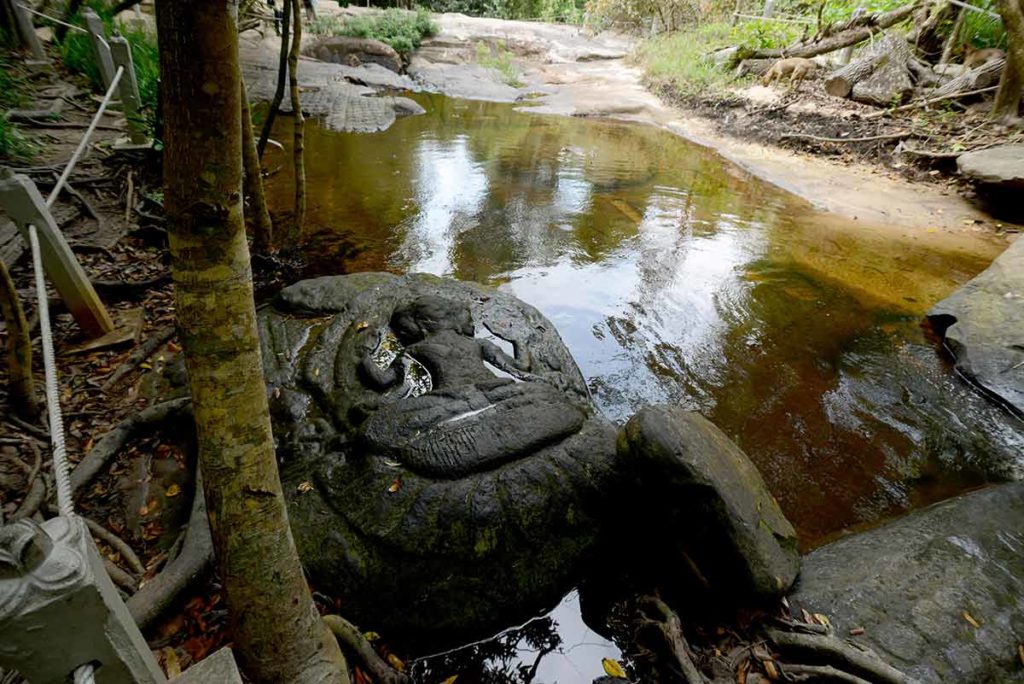
Of all the temples, this one has to be unique.
Not only is it further afield, to the North, and in the heart of Cambodian countryside, but it’s also underwater.
It’s approximately an hour to the ‘River of a Thousand Lingas’ (and probably requires a tuk-tuk or moto) followed by a short hike to the river.
However, it’s another temple to the North that’s worth the effort of getting there.
Get to a certain point of Kbal Spean river and look down to see ancient stone effigies and reliefs intricately carved into the rocks, covered in shimmering running water.
It’s a magical place, unlike any other I’ve seen.
There’s also an awesome little waterfall here, which you can cool off in with the locals.
It’s a seriously cool place to visit.
Time to Wrap Up
There you have it: a comprehensive guide to the Siem Reap Temples of Angkor.
This remarkable place is truly a world treasure. Anyone spending time in Cambodia would be foolish not to go and have a look around.
As there’s lots to see, it pays to spend some time planning the trip well especially if you haven’t got much time.
More Famous Landmarks in Asia:
Danny Newman is currently writing and travelling his way around the world in a bid to figure out exactly what he’s doing with his life. He’d love you to follow along with his journey over at What’s Danny Doing.
Plan Your Trip

Rent A Car – Find the best car rental rates at Discover Cars. They compare car hire companies to provide you with the best deal right now.

Find A Hotel – If you’re curious about this article and are looking for somewhere to stay, take a look at these amazing hotels.
